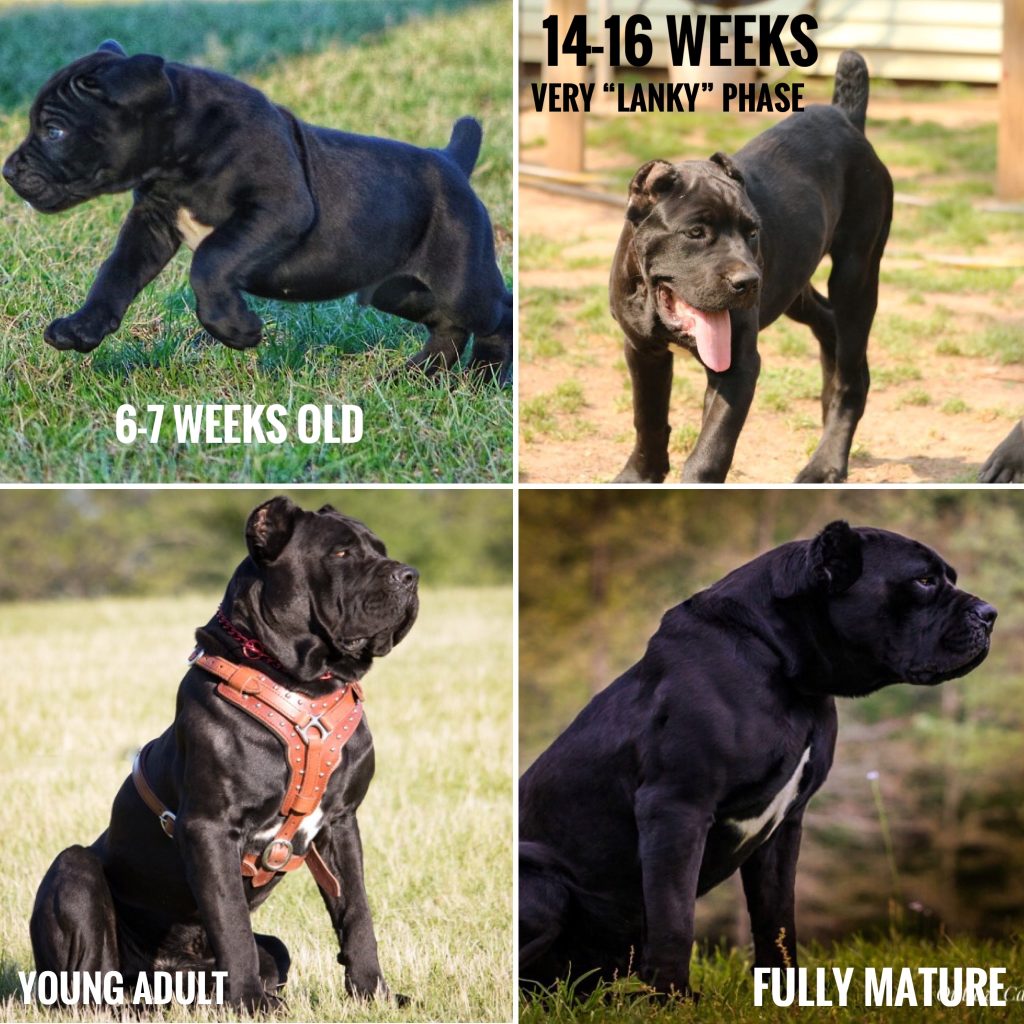Growth phases of Cane Corso puppies and some of what to expect.
We have had many years of experience watching Cane Corso puppies grow from birth to adulthood. During that time we have been able to learn much about the different growth phases of the Cane Corso and some of what to expect.
The world’s leading authority on this breed biologist Dr. Paolo Breber states that it’s very difficult to accurately predict exactly what a Cane Corso puppy may look like as an adult. His advice is to judge the appearance of the Sire and Dam then proceed from there. Our years of experience from working with this breed has led us to agree with the conclusions of Dr. Breber and his findings.
I will briefly describe some of what we have seen with our bloodline concerning the genetics and growth phases of the Cane Corso and why it can lead to certain difficulties when attempting to predict what a young puppy may look like as an adult.
The Cane Corso is classified as a working breed of dog. Unlike the show ring breeds this means it’s historically been bred with the emphasis placed on working temperament traits first. As such this can lead to slightly more variation in the physical appearance of this breed as compared to breeds that have been bred strictly for appearance. This may also be one of the reasons why we see a slight variance in the growth phases of different puppies within this breed. Different puppies within this breed seem to go through slightly different growth phases which makes it difficult to predict what a young puppy may look like as an adult.
As one example over the years we have noticed that some breedings produce puppies that have a more slender build but they may have the larger frames as adults. Some breedings do produce fatter puppies at first possibly due to the mothers milk being above average but when they are fully weaned off that milk and start eating dog food the size advantage goes away over the next few months and they are just normal size juveniles and adults. While it’s also true that on occasion some puppies are big as a puppy and as an adult. The genetic variation of certain breedings can be confusing if you don’t work with them daily. For instance Coda puppies ( when bred to Hero) will frequently produce a litter that has a slimmer build at first but end up being much larger in size adults on average. While Vegas puppies will almost always be very large as puppies (possibly due to her milk) but may end up just standard size as adults. Then there are some like Nala that (when bred certain males) tend to have larger puppies that remain large and are also larger adults. The genetics can be confusing.
We have noticed that many puppies tend to go through kind of awkward looking “lanky” phases as puppies. This can start as early as 8-12 weeks old. Many during this time change from a more cute, stocky, round, appearance to a taller almost skinny appearance. A lot of Corso puppies tend to grow up then out, up then out etc. etc. until adult hood is reached at approximately 2.5 years of age. Usually we see the final height being reached at approximately one year old then they continue to fill out from there.
I will show pics of one of our very best looking male stud dogs Outlaw’s Superman “Hero”. Hero started out as a well proportioned stocky looking puppy but then went through several kind of almost awkward looking lanky phases before he finally filled out as an adult.
Different litters seem to have slightly different looking growth phases thus making it more difficult to predict what a puppy may or may not look like as an adult.
As a breeder my years of experience have allowed me to become pretty good at guessing! but that’s just what it is.
Pictured is Outlaw’s Superman “Hero” @ approx 7 weeks old. Then approximately 14-16 weeks old then as young adult and finally as a fully mature male. Notice the lanky almost skinny appearance at 14-16 weeks old. Does this mean that every Corso that has “lanky” phases will end up as impressive as Hero? Sadly no, but it does mean that you definitely can’t rule a puppy out because of an awkward growth phase. This is an excellent example of but one of the possible growth phase variations that Dr. Breber may be referring to.
Outlaw Cane Corsos
(Copy righted)

